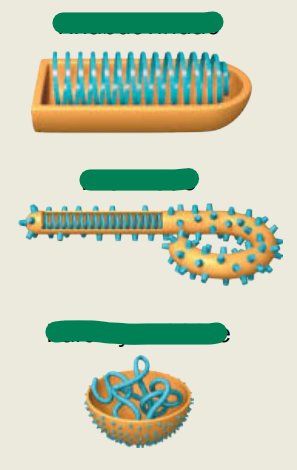Introduction to Viruses 1
1/36
There's no tags or description
Looks like no tags are added yet.
Name | Mastery | Learn | Test | Matching | Spaced |
|---|
No study sessions yet.
37 Terms
Contagium vivum fluidum
Latin word for poison
Adolf Mayer
Tobacco mosaic disease transferring between plants
Dmitri Ivanovsky
Showed infected sap remained infectious even after filtering through the finest chamberland filters
Martinus Beijerinck
Demonstrated the filterability of the agent; Realized that the disease could be used for serial transmission of disease without loss of potency
Loeffler and Frosh
Identified the first filterable agent from
animals–the virus of FMD (Food & Mouth)
obligatory
Virus is an _ intracellular parasites
living host cell
Virus absolutely require (type of host) to multiply
metabolism
Virus have few or no enzymes of their own for _
DNA, RNA
Virus contains a single type of nucleic acid, either _ or _
protein coat
Virus contains a (type of structural protein) that surrounds the nucleic acid
synthesizing machinery
Virus multiply inside living cells by using the (what machinery) of the cell
nucleic acids
Virus causes the synthesis of specialized structures that can transfer the viral (type of biomacromolecules) to other cells.
Host Range
the spectrum of host cells the virus can infect
plasma membranes
For animal viruses, the receptor sites are on _
Virion
A complete, fully developed viral particle composed of nucleic acid surrounded by a coat
Capsid
The protein coat surrounding the nucleic acid of a virus
capsomere
The capsid is composed of subunits, _, which
can be a single type of viral structure protein or several
types
bacteriophage
In the isolation, cultivation and identification of viruses, _ are the easiest viruses to grow
plaque method
Bacteriophages can be grown either in suspensions of bacteria in liquid media or in bacterial cultures on solid media (what method)
Using living animals, embryonated eggs, cell cultures
Methods involved in growing animal viruses in the laboratory
Embryonated eggs
The use of this method in growing animal viruses in the lab is fairly convenient and inexpensive form of host for many animal viruses
Embryonated eggs
It is used to grow viruses for some vaccines
Cell cultures
Using this method in growing animal viruses is more convenient to work with than whole animals or embryonated eggs
Western blotting
Common example of serological method in viral identifications
Restriction fragment length polymorphism, polymerase chain reaction
Virologists can identify and characterize viruses by using these modern molecular methods: (2)
type of nucleic acid, strategy for replication
In taxonomy of viruses: Classification of viruses is based on (type of what) and (strategy for what)
adenoviridae, papovaviridae
Double-stranded DNA (non-enveloped)

poxviridae, herpesviridae
Double-stranded DNA (enveloped)

parvoviridae
Single-stranded DNA (non-enveloped)

reoviridae
Double-stranded RNA (non-enveloped)

picornaviridae, caliciviridae
Single-stranded RNA, – strand (non-enveloped)

togaviridae, flaviviridae, coronaviridae
Single-stranded RNA, – strand (enveloped)

rhabdoviridae, filoviridae, paraxyoviridae
Single-stranded RNA, – strand (one strand of RNA, enveloped)

orthomyxoviridae, bunyaviridae, arenaviridae
Single-stranded RNA, – strand (multiple strands of RNA, enveloped)

deltaviridae
Single-stranded RNA, – strand (virusoid or satellite RNA)
retroviridae
Single-stranded RNA, produce DNA (enveloped)
hepadnaviridae
Double-stranded DNA, use reverse transcriptase, enveloped